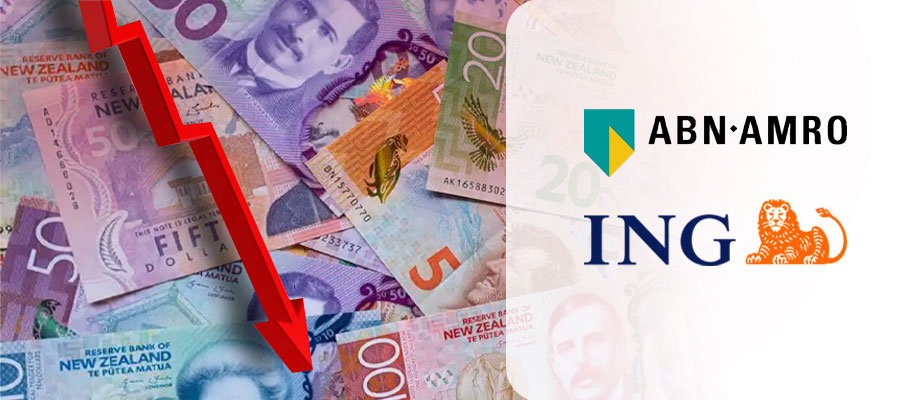
Published: March 6th, 2024
The New Zealand Dollar may have fallen against G10 peers in recent trading, but analysts at two of The Netherlands’ largest banks say the Kiwi is still on track to be one of this year’s outperformers.
NZD lost ground against other majors in February after Auckland central bankers held the official interest rate at 5.50%, disappointing some forex traders who were counting on another near-term rate hike. Guidance from the Reserve Bank of New Zealand’s (RBNZ) February meeting prompted a selloff and reappraisal of New Zealand interest rate prospects, with bets firming up for a new round of cuts in the Autumn.
In a note to investors, ING Bank’s FX Strategy Unit wrote that the RNBZ’s statement was ‘less hawkish than expected given that another rate hike looks to be off the table for the foreseeable future. The immediate result has been losses for the New Zealand dollar.’
But ING added that traders ‘shouldn't buy into perceptions of NZD weakness. Over at fellow Dutch banking giant ABN AMRO, currency analysts are in broad agreement. A market analysis published this week says the New Zealand dollar 'is still on track to outperform’ in 2024.
The New Zealand Dollar fell when the RBNZ cut its own official interest rate forecasts from 5.69 per cent in November 2023 to 5.60 per cent in February 2024, reducing the implied probability of a rate rise to below 40 per cent.
A statement from the central bank after its scheduled February meeting used softer language to describe the likelihood of additional tightening, prompting traders to price-in 2024's first rate cut for September.
At the end of November 2023, the New Zealand Dollar was the best-performing major currency thanks to positive global market conditions, new measures by China to kick-start the country’s slumbering economy, and a recent print of upbeat retail sales figures.
A market analysis from Crédit Agricole’s Currency Strategy Unit said rising New Zealand retail sales had made the Kiwi the G10’s top performing currency for the month of November.
Figures from Stats NZ showed that Q3 2023 retail sales volumes hit zero per cent quarter-on-quarter, much higher than the negative -0.8 per cent consensus was looking for and sharply up from Q2's negative -0.9 per cent.
The numbers provided some hope that the GDP print due for publication on 14th December would come in above expectations, likely giving NZD another boost.
But the bank also pointed to global drivers as key to the Kiwi's upward momentum, given that November was also shaping up to be the best month of the year for global stock markets.
Upbeat investor sentiment tends to be supportive of the New Zealand Dollar and helped it advance against all G10 peers in late 2023 except the Swedish Krona.
The Kiwi also extended its short-term strength thanks to good news out of China, where Beijing announced fresh measures to boost the domestic property sector.
‘In addition to signs that disinflation is taking hold globally, China has added to prevailing market optimism by announcing a robust support plan designed to aid the country’s property developers,’ says Crédit Agricole.
Beijing announced in early November that it would allow Chinese banks to offer unsecured short-term loans to qualified developers. As New Zealand's biggest customer for commodity exports, Chinese economic news can be a support or drag on the Kiwi. In fact, NZD is often considered a liquid proxy for exposure to China.
But the bank’s analysts did caution that it might be too soon to sound the all-clear for Chinese economic growth, and by extension, the New Zealand Dollar.
‘While real estate sector support looks positive on paper, it does suggest Beijing is worried about a potential crisis brewing.’
Analysts were less bullish back in March 2023, when NZD held its own among the G10 majors and rallied past a new technical milestone. Despite the uptrend some said the risk of a downside correction was also on the rise.
NZD was slightly behind its commodity-currency cousins the Norwegian Krone and Australian dollar at the end of the month but rose against all other majors in a rally that chipped away at two significant levels of technical chart resistance.
NZD/USD overturned more than half its decline from July 2022 in late March. In a note to investors, Australian investment bank Westpac said that NZD’s next moves to watch would be against the greenback. ‘As commodity prices rise further and continue to support the New Zealand Dollar, we believe 0.7100-plus could be achievable by July.’
The Kiwi had already been performing well before American exchange rates dipped lower and gave it an added tailwind against the US Dollar, added Westpac analysts. Gains in agricultural commodity prices also provided a lift.
‘The next moves for NZD will hinge on geopolitical events. Higher prices for commodity exports and high outright yields will stay as essential NZD supports.’
Agricultural commodity prices rose sharply in 2022, driven by sanctions against Russia for its invasion of Ukraine and previous supply chain disruptions caused by the long COVID-19 pandemic. The Kiwi saw gains against that backdrop, while also benefiting from central bank interest rate policy.
The Reserve Bank of New Zealand’s (RBNZ) said in February 2022 that it expected to raise its interest rate even further than previously planned in order to cap domestic inflation pressures throughout the year. That led many economists to raise forecasts for the country’s official cash rate.
Some local analysts, however, were more reserved about New Zealand’s economic growth prospects and believed there was potential for the US Dollar to rise further in the near term.